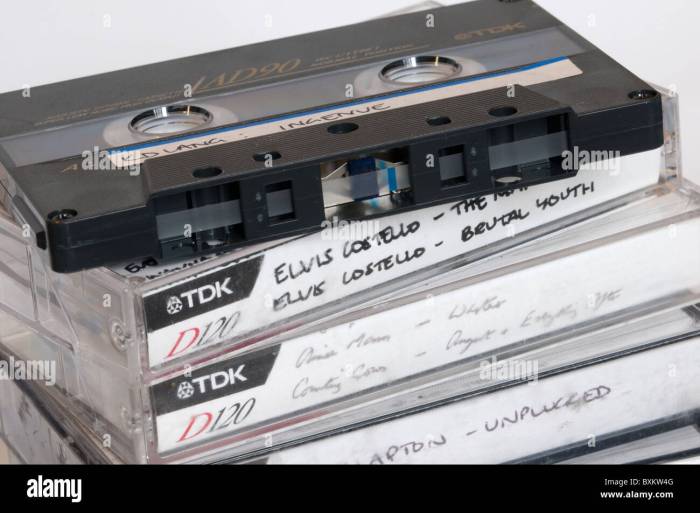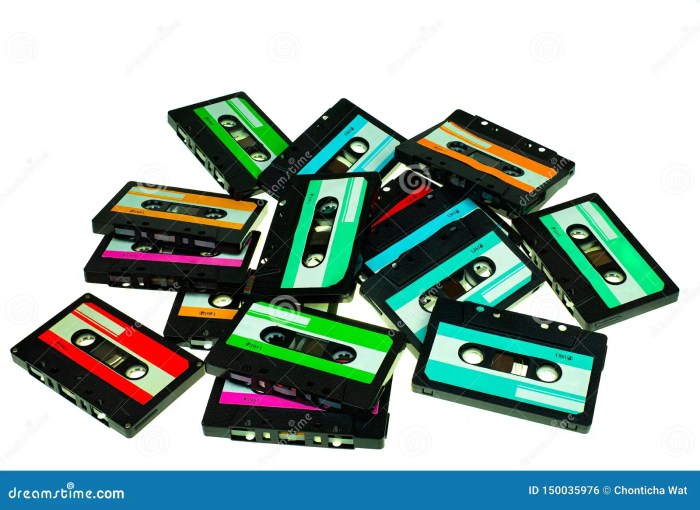Stack of cassette tapes – Cassette tapes, once ubiquitous in the music and entertainment industry, have left an enduring mark on popular culture. This comprehensive exploration delves into the history, design, uses, and cultural significance of this iconic audio format, providing a nostalgic journey through the annals of sound.
From their humble beginnings to their widespread adoption and eventual decline, cassette tapes have played a pivotal role in shaping our musical experiences and preserving precious memories. Their compact size, portability, and ease of use made them an indispensable tool for musicians, audio enthusiasts, and everyday listeners alike.
History of Cassette Tapes
Cassette tapes have a rich history that spans several decades. Their development and evolution have played a significant role in the music industry and popular culture.
In 1963, Philips introduced the Compact Cassette (CC), which quickly gained popularity due to its portability and affordability. It revolutionized the way music was consumed and shared, enabling people to create their own mixtapes and listen to music on the go.
In the 1970s, cassette tapes became the dominant format for recording and distributing music. They were used by musicians and record labels alike, leading to the rise of cassette-only releases and the popularity of mixtapes.
The 1980s saw the introduction of the Digital Audio Tape (DAT), which offered higher audio quality than CC tapes. However, DAT failed to gain widespread adoption due to its high cost and compatibility issues.
In the 1990s, cassette tapes faced competition from newer formats such as CDs and MP3s. While they declined in popularity for music distribution, they continued to be used for other applications such as data storage and educational purposes.
Physical Characteristics and Design
Cassette tapes consist of several physical components:
- Tape housing: A rectangular plastic casing that protects the tape
- Magnetic tape: A thin, flexible strip of plastic coated with magnetic particles, which store the audio data
- Spools: Two reels that hold and wind the magnetic tape
- Pressure pad: A felt or foam pad that presses the tape against the playback head
- Record/playback head: A magnetic transducer that reads and writes data to the tape
When recording audio on a cassette tape, the record head magnetizes the particles on the tape in a pattern that corresponds to the audio signal. During playback, the playback head reads these magnetized particles and converts them back into an electrical signal, which is then amplified and played through speakers.
Tape Formats and Compatibility
There are several different cassette tape formats, each with its own unique characteristics:
Compact Cassette (CC)

The most common cassette tape format, introduced in 1963. It uses a 3.81 mm wide tape and has a playing time of up to 60 minutes per side.
Digital Audio Tape (DAT)

Introduced in 1987, DAT uses a digital recording method to achieve higher audio quality than CC tapes. It has a playing time of up to 120 minutes per side.
Mini Cassette, Stack of cassette tapes
A smaller cassette format, introduced in 1967. It uses a 1.5 mm wide tape and has a playing time of up to 30 minutes per side.
Cassette tapes are not always compatible between different formats. CC tapes are not compatible with DAT players, and DAT tapes are not compatible with CC players. Mini cassettes require a special player designed specifically for them.
Audio Quality and Fidelity
The audio quality of cassette tapes depends on several factors, including:
- Tape speed: The speed at which the tape moves past the record/playback head. Higher speeds result in better audio quality.
- Tape formulation: The type of magnetic particles used on the tape. Different formulations offer different levels of audio quality.
- Player quality: The quality of the cassette player can also affect audio quality.
Cassette tapes generally have lower audio quality than other formats such as vinyl records and digital audio files. However, they offer a unique sound that is often described as warm and nostalgic.
Uses and Applications
Cassette tapes have been used for a variety of purposes, including:
- Music recording and playback
- Data storage
- Educational purposes
Cassette tapes are particularly well-suited for music recording and playback due to their portability and affordability. They are also easy to use, making them a popular choice for home recording and live performances.
Cassette Tape Players and Recorders

There are many different types of cassette tape players and recorders available, ranging from portable models to desktop systems.
Portable cassette players are designed for personal use and can be easily carried around. They typically have built-in speakers and a headphone jack.
Desktop cassette players and recorders are designed for use in a home or studio setting. They typically have more features and higher-quality components than portable models.
Collectibility and Preservation: Stack Of Cassette Tapes
Cassette tapes have become increasingly collectible in recent years. Factors that contribute to their collectibility include:
- Rarity: Some cassette tapes are rare and difficult to find.
- Condition: The condition of a cassette tape can affect its value.
- Historical significance: Cassette tapes that have been associated with famous musicians or events can be valuable.
To preserve cassette tapes, it is important to store them in a cool, dry place away from direct sunlight and heat. It is also important to handle them carefully and avoid touching the magnetic tape.
Cultural and Nostalgic Significance
Cassette tapes have a strong cultural and nostalgic significance for many people. They are associated with a time when music was more personal and tangible.
Cassette tapes were often used to create mixtapes, which were a way to share music with friends and loved ones. They were also a popular way to record live performances and radio broadcasts.
Today, cassette tapes continue to be used by some musicians and enthusiasts who appreciate their unique sound and nostalgic appeal.
Expert Answers
What factors contribute to the collectibility of cassette tapes?
Rarity, condition, and historical significance are key factors that determine the value of cassette tapes among collectors.
How can I preserve my cassette tape collection?
Store tapes upright in a cool, dry place away from direct sunlight and extreme temperatures. Clean tapes regularly with a soft cloth and avoid rewinding or fast-forwarding too quickly.
What are some of the advantages of using cassette tapes for music recording?
Cassette tapes offer a warm, analog sound that some prefer over digital formats. They are also relatively inexpensive and easy to use, making them a good option for home recording.
